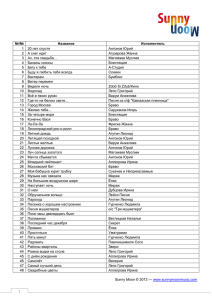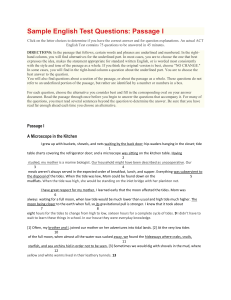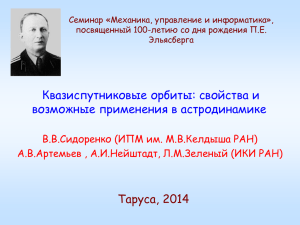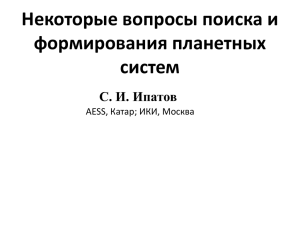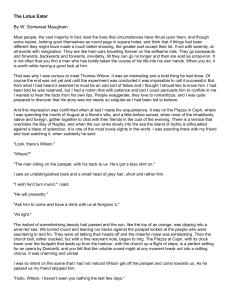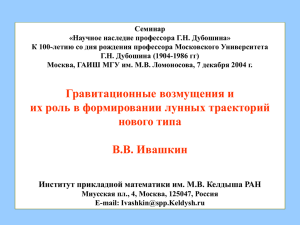(астрономия + английский язык) по теме «Луна
advertisement
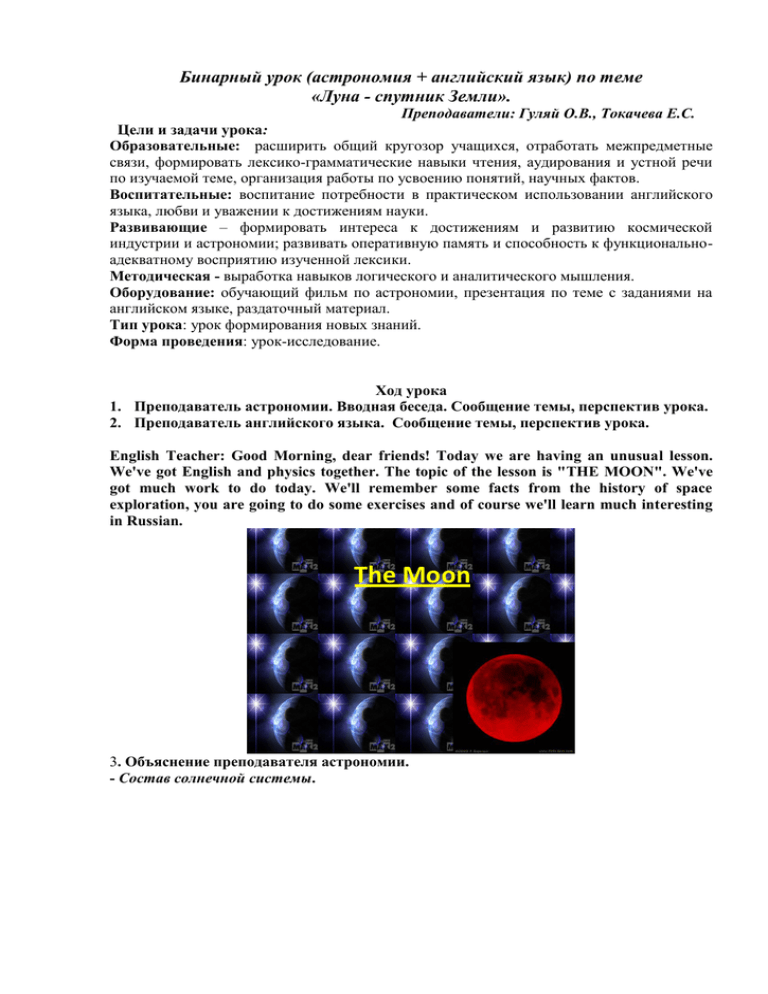
Бинарный урок (астрономия + английский язык) по теме «Луна - спутник Земли». Преподаватели: Гуляй О.В., Токачева Е.С. Цели и задачи урока: Образовательные: расширить общий кругозор учащихся, отработать межпредметные связи, формировать лексико-грамматические навыки чтения, аудирования и устной речи по изучаемой теме, организация работы по усвоению понятий, научных фактов. Воспитательные: воспитание потребности в практическом использовании английского языка, любви и уважении к достижениям науки. Развивающие – формировать интереса к достижениям и развитию космической индустрии и астрономии; развивать оперативную память и способность к функциональноадекватному восприятию изученной лексики. Методическая - выработка навыков логического и аналитического мышления. Оборудование: обучающий фильм по астрономии, презентация по теме с заданиями на английском языке, раздаточный материал. Тип урока: урок формирования новых знаний. Форма проведения: урок-исследование. Ход урока 1. Преподаватель астрономии. Вводная беседа. Сообщение темы, перспектив урока. 2. Преподаватель английского языка. Сообщение темы, перспектив урока. English Teacher: Good Morning, dear friends! Today we are having an unusual lesson. We've got English and physics together. The topic of the lesson is "ТHE MOON". We've got much work to do today. We'll remember some facts from the history of space exploration, you are going to do some exercises and of course we'll learn much interesting in Russian. The Moon 3. Объяснение преподавателя астрономии. - Состав солнечной системы. слайд. Все планеты солнечной системы Луна рядом с Землей. Луна самый удобный космический объект для изучения. 2 слайд. Теория возникновения Луны: - когда-то отделилась то Земли - теория захвата - образование Земли с Луной как двойной планеты. 1 3 слайд. Поверхность Луны. 4 слайд Большое количество кратеров. Научный спор: кратеры вулканического или метеоритного происхождения. Метеоритная теория является общепринятой. Лунный грунт был изучен в 50-е годы .Физические условия достаточно суровые: температура днем до + 120 – 130˚С, а ночью - - 150 ˚С. 2 слайд. Вращение Луны. Земля в 81 раз массивнее луны, ее приливы примерно в 20 раз сильнее тех, которые Луна вызывает на нашей планете. С Земли можно наблюдать 59% лунной поверхности. 3 слайд. Движение Луны. Еще во II веке до н.э. Гиппарх определил наклон лунной орбиты к плоскости эклиптики и выявил ряд особенностей движения Луны. Затем эту теорию развил александрийский астроном Клавдий Птолемей. Полный оборот вокруг Земли Луна совершает за 27,3 суток- это ее звездный или сидерический период. 4. Преподаватель английского языка. - Let’s review the name of the planets. Mercury Марс Uranus Сатурн Jupiter Венера Venus Нептун Neptune Земля Earth Меркурий Saturn Юпитер Mars Плутон 5.Преподаватель астрономии. - Теория возникновения Луны, ее поверхность. 6. Преподаватель английского языка. Введение лексики по теме: - Определите значения слов по их фонетическому и графическому сходству с русскими словами: (слайд 2). astronomer experiment device temperature energy substance theory influence crater the universe galaxy space spaceship planet the Solar Sistem Определите значения слов по их фонетическому и графическому сходству с русскими словами - Проверьте себя: (слайд 3). Проверьте себя. астроном эксперимент приборы температура энергия вещество теория влияние кратер Вселенная галактика космос космический корабль планета Солнечная система - Подберите к каждому определению верный ответ: (слайд 4). 1. It is a space and everything that exist in it. 2. It is a huge group of stars and planets. 3. It is a place far above the Earth where there is no air. 4. It is a rocket or other vehicle that can travel in space. 5. It is a large, round object that goes round a star. 6. It is the Sun together with the planets going round it. the universe galaxy a space a spaceship planet the Solar System the Solar universe System Подберите к каждому определению верный ответ. 1.It is a space and everything that exist in it. 2.It is a huge group of stars and planets. 3.It is a place far above the Earth where there is no air. 4.It is a rocket or other vehicle that can travel in space. 5.It is a large, round object that goes round a star. 6.It is the Sun together with the planets going round it. the universe galaxy a space a spaceship planet the Solar System 7. Работа с текстом: (слайд 5). Текст. Though a satellite of Earth, the Moon is bigger than Pluto. Some scientists think of it as a planet (four other moons in our solar system are even bigger). There are various theories about how the Moon was created, but recent evidence indicates it formed when a huge collision tore a chunk of the Earth away. Because it takes 27.3 days both to rotate on its axis and to orbit Earth, the Moon always shows us the same face. We see the Moon because of reflected sunlight. How much of it we see depends on its position in relation to Earth and the Sun. The 27.3-day number is what scientists call a sidereal month, and it is how long it takes the Moon to orbit the Earth in relation to a fixed star. Another measurement, called a synodic month, is measured between in relation to the Sun and equals 29.5 days. Full moons and new moon are measured by the synodic month. Earth's gravity keeps the Moon in orbit, while the Moon's gravity creates tides on our oceans Like the four inner planets, the Moon is rocky. It's pockmarked with craters formed by asteroid impacts millions of years ago. Because there is no weather, the craters have not eroded. The Moon has almost no atmosphere, so a layer of dust -- or a footprint -- can sit undisturbed for centuries. And without an atmosphere, heat is not held near the planet, so temperatures vary wildly. Daytime temperatures on the sunny side of the Moon reach 273 degrees F; on the dark side it gets as cold as -243. In June of 1999, reserchers discovered by accident that a huge cloud of sodium gas trails behind the Moon. The Lunar Prospector in 1998 provided evidence of ice near the Moon's poles, perhaps as much as 6 billion tons of it. The Moon travels around the Earth at a little more than half a mile per second; its speed is slowing and the satellite is gradually moving away from Earth. • Moon ,, Though a satellite of Earth, the Moon is bigger than Pluto. Some scientists think of it as a planet (four other moons in our solar system are even bigger). There are various theories about how the Moon was created, but recent evidence indicates it formed when a huge collision tore a chunk of the Earth away. Because it takes 27.3 days both to rotate on its axis and to orbit Earth, the Moon always shows us the same face. We see the Moon because of reflected sunlight. How much of it we see depends on its position in relation to Earth and the Sun. The 27.3-day number is what scientists call a sidereal month, and it is how long it takes the Moon to orbit the Earth in relation to a fixed star. Another measurement, called a synodic month, is measured between in relation to the Sun and equals 29.5 days. Full moons and new moon are measured by the synodic month. Earth's gravity keeps the Moon in orbit, while the Moon's gravity creates tides on our oceans Like the four inner planets, the Moon is rocky. It's pockmarked with craters formed by asteroid impacts millions of years ago. Because there is no weather, the craters have not eroded. The Moon has almost no atmosphere, so a layer of dust -- or a footprint -- can sit undisturbed for centuries. And without an atmosphere, heat is not held near the planet, so temperatures vary wildly. Daytime temperatures on the sunny side of the Moon reach 273 degrees F; on the dark side it gets as cold as -243. In June of 1999, reserchers discovered by accident that a huge cloud of sodium gas trails behind the Moon. The Lunar Prospector in 1998 provided evidence of ice near the Moon's poles, perhaps as much as 6 billion tons of it. The Moon travels around the Earth at a little more than half a mile per second; its speed is slowing and the satellite is gradually moving away from Earth. - Ответьте на вопросы по тексту: (слайд 6). • Is the Moon bigger than Pluto? • Are there various theories about how the Moon was created? • Why do we see the Moon? • Are full moons and new moon measured by the synоdic month? Has the Moon аn atmosphere? Ответьте на вопросы по тексту: • Is the Moon bigger than Pluto? • Are there various theories about how the Moon was created? • Why do we see the Moon? • Are full moons and new moon measured by the synоdic month? • Has the Moon аn atmosphere? - Дополните предложения в соответствии с текстом: (слайд 7). • Some scientists think of it … • Because it takes 27.3 days both to rotate on its axis and to orbit Earth, the Moon … • The 27.3-day number is what scientists call a sidereal month, and it is how… • Full moons and new moon … • Daytime temperatures on the sunny side of the Moon… Дополните предложения в соответствии с текстом. • Some scientists think of it … • Because it takes 27.3 days both to rotate on its axis and to orbit Earth, the Moon … • The 27.3-day number is what scientists call a sidereal month, and it is how… • Full moons and new moon … • Daytime temperatures on the sunny side of the Moon… - Найдите в тексте словосочетания, являющиеся эквивалентами русских: (слайд 8). Различные теории, огромное столкновение, отраженный солнечный свет, неподвижная звезда, полная луна, почти нет атмосферы, дневные температуры, огромное облако. Найдите в тексте словосочетания, являющиеся эквивалентами русских. • Различные теории, огромное столкновение, отраженный солнечный свет, неподвижная звезда, полная луна, почти нет атмосферы, дневные температуры, огромное облако. - Составьте предложения: (слайд 9). • Of years, dreamed, of flying, for thousands, man, to the stars. • The Russians, in the world, into outer space, were the 1st, to fly. • of man's exploration, of outer space, a new era, began. • Many , went up, cosmonauts, space rockets, by our . Составьте предложения. • Of years, dreamed, of flying, for thousands, man, to the stars. • The Russians, in the world, into outer space, were the 1st, to fly. • of man's exploration, of outer space, a new era, began. • Many , went up, cosmonauts, space rockets, by our . - Проверьте себя: (слайд 10) • For thousands of years man dreamed of flying to the stars. • The Russians were the 1st in the world to fly into outer space • A new era of man's exploration of outer space began. • Many space rockets went up by our cosmonauts. Проверьте себя. • For thousands of years man dreamed of flying to the stars. • The Russians were the 1st in the world to fly into outer space • A new era of man's exploration of outer space began. • Many space rockets went up by our cosmonauts. 8. Преподаватель астрономии. - Карточки задания (Закрепление материала). Самостоятельная работа по астрономии. 1. Причиной резкого перепада температур является ……. 2. Темные пятна на поверхности Луны – это ….. 3. Самыми многочисленными образованиями на поверхности Луны являются кратеры – это ……. 4. Лунный грунт называют ….. 5. Почему подробная карта Луны была составлена только в 1965 году? 6. Достоверная гипотеза образования Луны …… 5. Домашнее задание: (слайд 11). Домашнее задание. • Выучить новый лексический материал. • Подготовить выступление по теме на английском языке. 6. Подведение итогов, выставление оценок.
